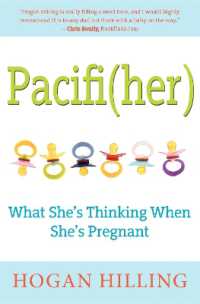- ホーム
- > 洋書
- > 英文書
- > Nature / Ecology
Full Description
Primatology, Ethics and Trauma offers an analytical re-examination of the research conducted into the linguistic abilities of the Oklahoma chimpanzees, uncovering the historical reality of the research. It has been 50 years since the first language experiments on chimpanzees. Robert Ingersoll was one of the researchers from 1975 to 1983. He is well known for being one of the main carers and best friend of the chimpanzee, Nim Chimpsky, but there were other chimpanzees in the University of Oklahoma's Institute for Primate Studies, including Washoe, Moja, Kelly, Booee, and Onan, who were taught sign language in the quest to discover whether language is learned or innate in humans. Antonina Anna Scarnà's expertise in language acquisition and neuroscience offers a vehicle for critical evaluation of those studies.
Ingersoll and Scarnà investigate how this research failed to address the emotional needs of the animals. Research into trauma has made scientific advances since those studies. It is time to consider the research from a different perspective, examining the neglect and cruelty that was inflicted on those animals in the name of psychological science. This book re-examines those cases, addressing directly the suffering and traumatic experiences endured by the captive chimpanzees, in particular the female chimpanzee, Washoe, and her resultant inability to be a competent mother.
This book discusses the unethical nature of the studies in the context of recent research on trauma and offers a specific and direct psychological message, proposing to finally close the door on the language side of these chimpanzee studies. This book is a novel and groundbreaking account. It will be of interest to lay readers and academics alike. Those working as research, experimental, and clinical psychologists will find this book of interest, as will psychotherapists, linguists, anthropologists, historians of science and primatologists, as well as those involved in primate sanctuary and conservation.
Contents
1. Acknowledgment 2. Chimpanzee Family Trees 3. Introduction 4. Chapter 1: 50 Years Later 1.1 Fifty years since language experiments on chimpanzees 1.2 When we swap chimpanzee for child 1.3 A biography of Washoe 5. Chapter 2: Narratives for Flourishing 2.1 Why language and Noam Chomsky for Nim Chimpsky? 2.2 The introduction of language to a chimpanzee, order of the signs, and human parallels 2.3 Age of acquisition, order of acquisition 2.4 Trauma and language 6. Chapter 3: One of Us 3.1 Humans' need for a healthy upbringing and the needs of a chimpanzee 3.2 Washoe in her enclosure, existing not living, and self efficacy in humans 3.3 Survivors: The effects of trauma on the brain in humans: the Romanian orphanages and the Holocaust 3.4 "Man is the master of animals": the morality behind the authoritarian model over chimpanzees 7. Chapter 4: The Truth About Washoe 4.1 Washoe's preparation for mothering. What do good mothers do? 4.2 The true story of the death of Sequoyah 4.3 Was Washoe abnormal? Definition of abnormality in humans and in chimpanzees, with use of the DSM-5 4.4 Parental narcissism in humans and in chimpanzees: a sense of self worth, parental neglect, and chimpanzee trust 8. Chapter 5: Post Traumatic Chimpanzees 5.1 Did Washoe have complex PTSD? Living conditions and the turning of James Mahoney 5.2 Finding and building sanctuary 9. Chapter 6: When All The Chimps Have Gone 6.1 How do we look to the future? 6.2 How not to repeat history. Existing models of good practice 6.3 How to honour the memory of Washoe and the other Oklahoma chimpanzees 6.4 The last word







